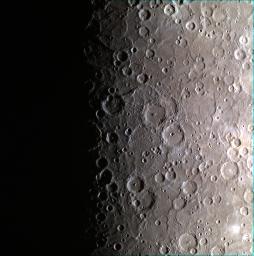
|
The Color Out of Space
- Click the image above for a larger view
- Full-Res JPEG (508 x 512) (43.6 kB)
- Full-Res TIFF (508 x 512) (780.8 kB)
Caption:
Today's image features a color view of the southern pole of Mercury. About midway down the image, the edge of the large Chao Meng-Fu crater, which lies almost directly on the south pole, can be seen poking out from the shadows . Surrounding Chao Meng-Fu are Roerich, Lovecraft , Hurley and L'Engle craters. This image was obtained as part of the 11-color south polar imaging campaign, through which scientists hope to be able to use the relative brightness of the surface in different colors to understand its composition.
Date acquired:
January 24, 2015
Image Mission Elapsed Time (MET):
64435215, 64435211, 64435209
Image ID:
7855654, 7855652, 7855651
Instrument:
Wide Angle Camera (WAC) of the Mercury Dual Imaging System (MDIS)
WAC filters:
9, 7, 6 (996, 748, 433 nanometers) in red, green, and blue
Center Latitude:
-84.91°
Center Longitude:
341.0° E
Resolution:
2880 meters/pixel (1.79 mi./pixel)
Scale:
The right edge of the image is ~1535 km (954 mi.) from top to bottom.
Incidence Angle:
85.2°
Emission Angle:
2.3°
Phase Angle:
82.9°
North is to the right in this image.
Background Info:
The MESSENGER spacecraft is the first ever to orbit the planet Mercury, and the spacecraft's seven scientific instruments and radio science investigation are unraveling the history and evolution of the Solar System's innermost planet. During the first two years of orbital operations, MESSENGER acquired over 150,000 images and extensive other data sets. MESSENGER is capable of continuing orbital operations until early 2015.
For information regarding the use of images, see the MESSENGER image use policy .
Cataloging Keywords:
| Name | Value | Additional Values |
|---|---|---|
| Target | Mercury | |
| System | ||
| Target Type | Planet | |
| Mission | MESSENGER | |
| Instrument Host | MESSENGER | |
| Host Type | Orbiter | |
| Instrument | Mercury Dual Imaging System (MDIS) | |
| Detector | Wide Angle Camera (WAC) | |
| Extra Keywords | Color, Crater, Radio, Shadow | |
| Acquisition Date | ||
| Release Date | 2015-02-16 | |
| Date in Caption | 2015-01-24 | |
| Image Credit | NASA/Johns Hopkins University Applied Physics Laboratory/Carnegie Institution of Washington | |
| Source | photojournal.jpl.nasa.gov/catalog/PIA19204 | |
| Identifier | PIA19204 | |
